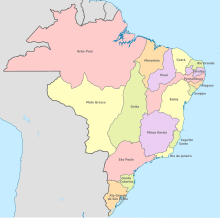Viceroyalty of Brazil
This article possibly contains original research. (September 2018) |

The Viceroyalty of Brazil refers, in narrow scope, to office of
Portuguese court transferred to Brazil in 1808
, with the State of Brazil becoming directly administered by the Portuguese Government seated in Rio de Janeiro.
History
Since the 17th century, the title of "viceroy" was granted occasionally to some governors of the State of Brazil, who were members of the Portuguese high nobility, with the first being D. Jorge Mascarenhas, marquis of Montalvão, who assumed the office in 26 May, 1640. The remaining, kept the title of "governor-general".
Around 1763, at the same time that the capital of the State of Brazil was transferred from
Minas dos Matos Gerais
: São Sebastião do Rio de Janeiro was the port where the gold was sent to Portugal, and consequently the point of contact between metropolis and colony.
In 1775, the remaining states of the
Maranhão and Grão-Pará
) were integrated in the State of Brazil, becoming under the authority of its viceroy, the capital maintained in Rio de Janeiro.
In 1808, with the
Transfer of the Portuguese Court to Brazil, the Prince Regent (future John VI of Portugal) assumed direct control of the government of the State of Brazil, suppressing the office of viceroy. In 1815, the status of the State of Brazil was raised, becoming the Kingdom of Brazil, as one of the constituent kingdoms of the newly created United Kingdom of Portugal, Brazil and the Algarves
.
Composition
Captaincies from merger of State of Maranhão
- Captaincy of Cabo Norte
- Captaincy of Caeté
- Captaincy of Cametá
- Captaincy of Cumã
- Captaincy of Marajó
- Captaincy of Maranhão
- Captaincy of Pará
- Captaincy of Piauí 1759 split from Maranhao
- Captaincy of São José do Rio Negro
- Captaincy of Xingu
See also
- State of Grão-Pará and Maranhão
- Colonial Brazil-related topics
- Prince of Brazil
- State of Brazil
- Captaincies of Brazil
- Kingdom of Brazil
